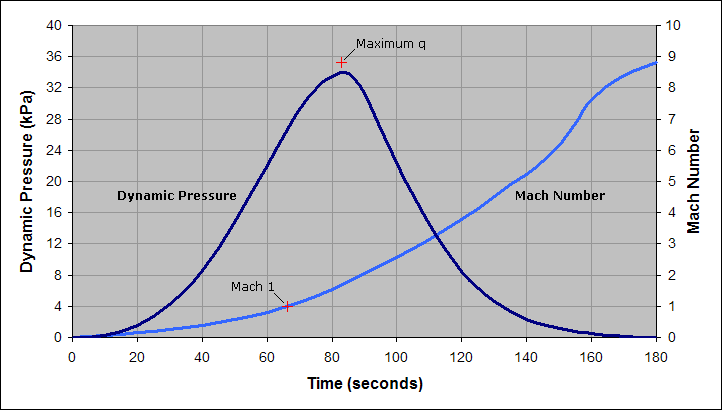When watching rocket launches, the commentary or status reports often mention that the vehicle is "passing through Max-Q" - how long does the "passing" take? Is the event instantaneous or is there some time interval while the dynamic pressure stays maximal?
-
6$\begingroup$ It is the absolute maximum of a function of time in the real world, and cannot be exactly equal to any other local maximum, so it is instantaneous. $\endgroup$– Mark AdlerCommented May 29, 2016 at 22:09
-
1$\begingroup$ @MarkAdler: If the ship throttles down, though, the period throttled down may be interpreted as the MaxQ period. The function's curve flattens over that period, in ideal conditions the maximum turning into a flat segment of specific length, the excessive values above safe threshold cut off through throttling. And length of that segment can be known. $\endgroup$– SF.Commented Sep 16, 2018 at 12:09
3 Answers
"Maximum Q" is technically instantaneous, but less formally it can refer to a period of time where pressures are nearly at maximum.
Here's a graph of dynamic pressure for a simulation of the Saturn V; (gone missing; archive.org link) most launchers will have an essentially similar curve. You can see that it peaks close to 34kPa, but it's above 95% of that value for a period of at least 10 seconds.
The mission abort criteria for the Saturn-Apollo flights use the term "max Q region" to refer to the period of flight time from 50 seconds to 2 minutes elapsed -- this span of time includes dynamic pressures only 1/4 that of the actual "max Q"!
-
$\begingroup$ Did the Saturn V have a throttle bucket like STS did? $\endgroup$– ErikCommented May 30, 2016 at 3:07
-
5$\begingroup$ No, the first-stage engines weren't throttleable. At T+135 seconds or so the center engine is shut off, but that's for acceleration limiting, well beyond max Q. Saturn V's structure was probably a bit more robust overall than shuttle's. $\endgroup$ Commented May 30, 2016 at 4:17
As the other answers say, the actual peak of dynamic pressure is an instaneous point, but actions taken around this time are often described in terms of Max Q. For example, Space Shuttles would throttle down their main engines for 30 seconds or so while Q peaked. (The SRB propellant grain was also shaped to lower thrust during this time, but that was pretty invisible.) Typical throttle command times for this "thrust bucket" were:
Throttle down from 104.5% to 74% --> 32.8 seconds Mission Elapsed Time
Throttle up from 74% to 104.5% ----> 54.4 seconds Mission Elapsed Time
Numbers are from STS-118, but are representative.
Max Q takes 21.6 s (according to ST-118 numbers) or 27 s (according to RocketLab numbers) or 12 s (from the test flight of Falcon Heavy).
-
3$\begingroup$ References would be great... Can you add them? $\endgroup$– user10509Commented Dec 30, 2018 at 10:51
-
$\begingroup$ What is your definition of max q? If you mean the instantaneous maximum value, this cannot be correct. $\endgroup$ Commented Dec 30, 2018 at 13:34
-
1$\begingroup$ I assume it's taking SF's description -- but this appears to be by someone who doesn't want to bother with setting up an account, which is why I didn't bother suggestion adding references. $\endgroup$– user20636Commented Dec 30, 2018 at 14:50
